Audemars Piguet: 150 years of excellence and innovations
“Everything you want to know about Audemars Piguet, without daring to ask” was the program of last Frank Sans C’s video filmed at the Audemars Piguet manufacture for their 150th anniversary. When Frank Sans C visited the Musée-Atelier Audemars Piguet, he asked the questions his followers sent him, thus offering a privileged immersion among the Swiss watchmaking world. The visit includes a walk around the temporary exhibition, an insight on the Grande Complication workshops and an exclusive interview of Ilaria Resta, the House’s CEO.
Next stop: the Musée-Atelier in Le Brassus
This year, the Audemars Piguet manufacture celebrates a historical milestone: their 150th anniversary. For the occasion, the house inaugurated last February a new temporary exhibition at the Musée-Atelier Audemars Piguet located in Le Brassus, where the company came into existence. This immersive experience called “The House of Wonders” is a tribute to the craftspeople, the engineers and the designers who’ve been shaping Audemars Piguet’s identity since 1875, with all their passion, know-how and precision.

The exhibition, designed as a seven-stages travel, introduces the visitors to the watchmaking universe of vallée de Joux – from historical archives to the portrait gallery, with a detour via a poetic forest or the façade of the first manufacture built in 1907. The scenery is also a tribute to the collaboration spirit peculiar to the Établissage, the historical mode of production that combined several specialised watchmaking workshops. “The House of Wonders” will remain open to everyone – watchmaking lovers or genuine curious persons – until the end of 2026.
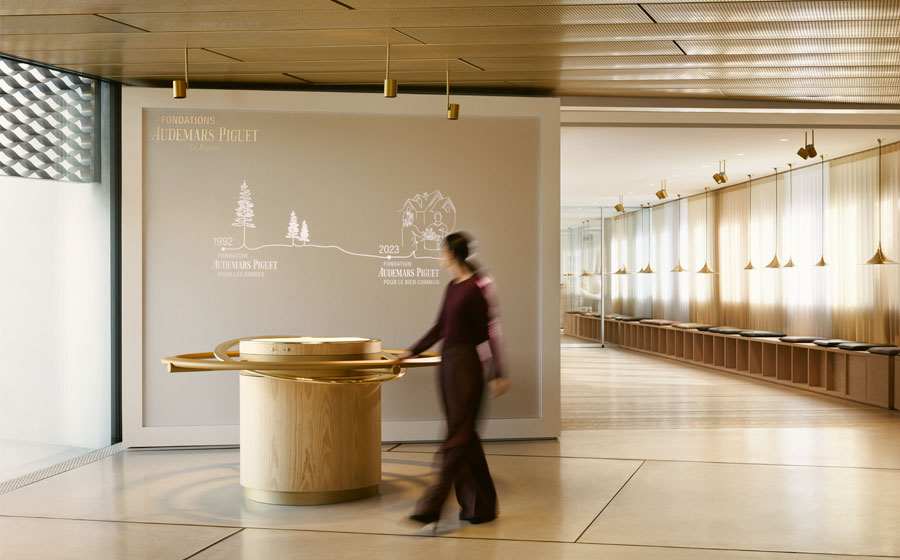
An interactive insight on the Foundations Audemars Piguet
Another novelty: the museum discloses a new recreational and interactive device dedicated to the Foundations Audemars Piguet. This installation set in “le hall des Fondateurs” intertwines watchmaking and astronomy to relate poetically more than 30 years of social and environmental engagement. Since their creation in 1992, the Foundations have supported, across 80 countries, more than 200 projects that strive for social justice, education and sustainability. This new space opens a new perspective on the impact of these actions, while highlighting Audemars Piguet’s desire to build a more sustainable and cohesive future.

Masterclasses for all ages
To complete the celebrations, 3 unprecedented masterclasses will be available all year long at the Musée-Atelier.

– “Shaping Materials – 150 years”: taking place every Thursday afternoon, this masterclass introduces 6 visitors to the most emblematic materials of the industry, as well as the evolution of Audemars Piguet’s techniques through pieces from their Heritage collection.
– Children aged from 8 to 12 are awaited every Wednesday afternoon for a fun initiation to the watchmaking world. With an accompanying adult, they will be immersed into the history of Le Brassus, will manipulate emblematic pieces and build a part of the Calibre 4302 – an experience designed to kindle vocations.
– Finally, the masterclass “The Royal Oak’s origins” occurs every Thursday afternoon. Limited to 4 people, the experience mixes theory and practice: after an immersion into the history of the iconic Royal Oak, the visitors will build its case and the Calibre 4302 movement, before trying characteristic decoration techniques.
Through this exhibition and these activities, Audemars Piguet invites visitors to discover their heritage through a different lens, both artistic, human and experimental. A new way to keep the Swiss high watchmaking industry alive, over and over again. The beat goes on…

GENERAL INFORMATION
The Musée-Atelier is accessible by booked guided visit only. To book your visit, please follow this link.
Address: Route de France 18, 1348 Le Brassus, Switzerland
Opening hours: every Tuesday to Friday from 2 p.m. and 3 p.m. / Every Saturday at 10 a.m., 11 a.m., 2 p.m. and 3 p.m.
Next stop: the Grandes Complications workshop
The new generation of Perpetual Calendars with the “all-in-one” crown, now in 41mm…
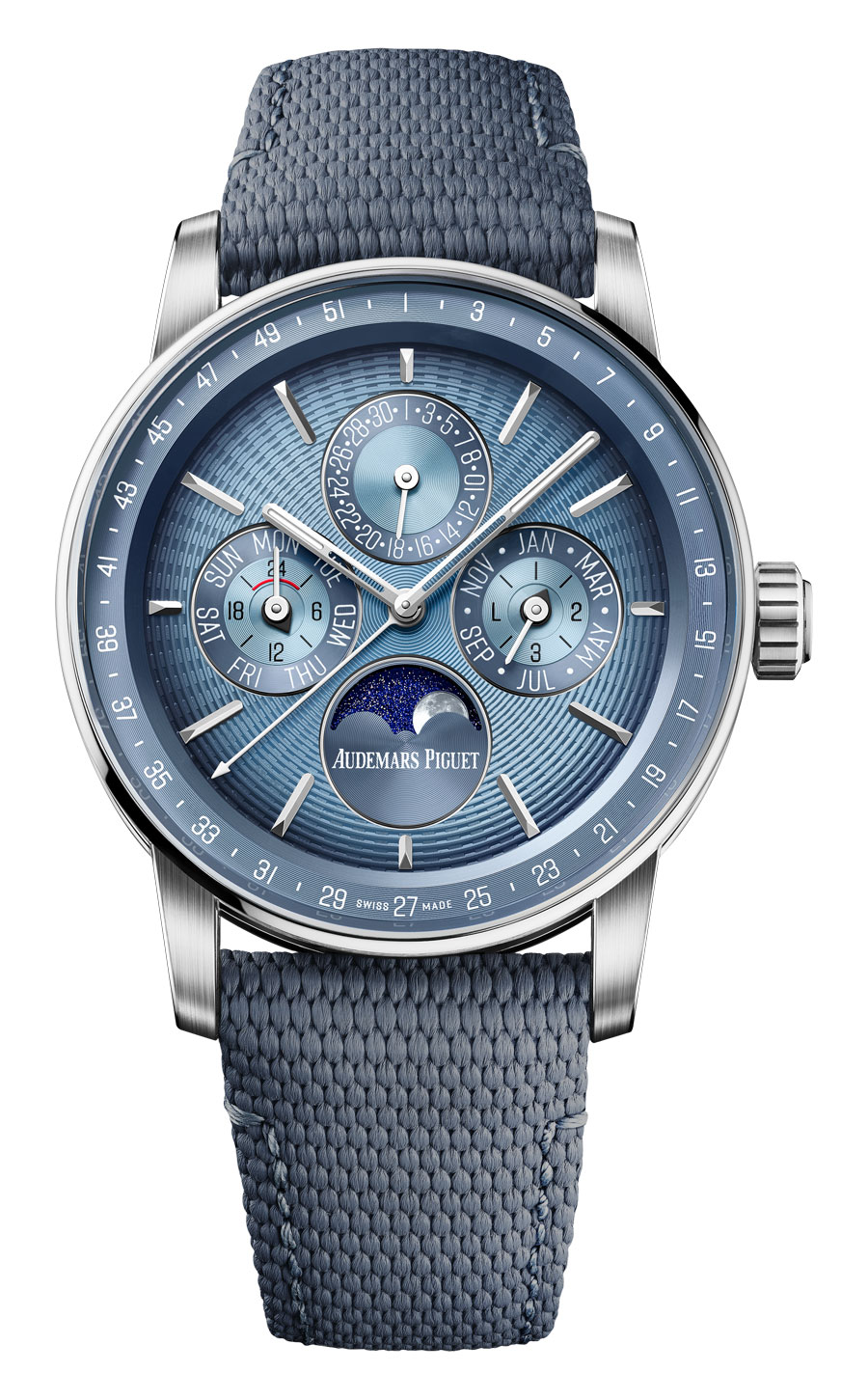
The model Code 11.59 by Audemars Piguet displays a refined aesthetics with a 18ct white gold case contrasting with a smoked blue dial and a matching rubber strap.
Audemars Piguet completely redesigned their perpetual calendar thanks to a major evolution, the Calibre 7138, a self-winding movement entirely revamped around an adjustment system unprecedented at AP’s: the “all-in-one” crown. This now-patented technical innovation marks a new threshold – that complication known to be hard to manage is now easy to handle.
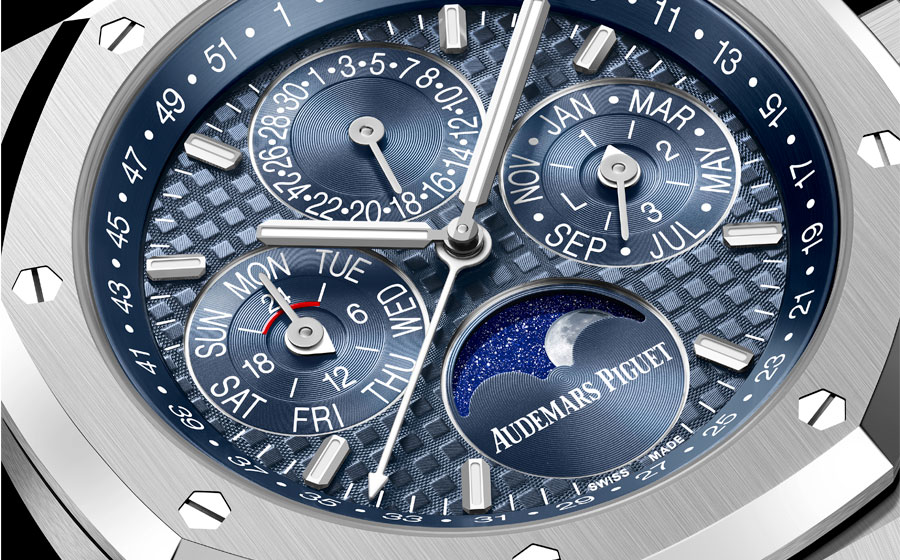
Traditionally, perpetual calendars require small lateral correctors integrated to the case band. Once activated with a specific tool, they help adjusting the day, date, month or moon phase indicators. This precise-yet-demanding device made the mechanism prone to errors or damage risks in case of incorrect manipulation.

Audemars Piguet chose to erase these correctors for the sake of a simplified ergonomic: now all the calendar functions can be adjusted directly via the crown. This system, both intuitive and mechanically sophisticated, is based on a four-positions crown. The first one helps winding up the watch, the second one adjusts the date, the month and the leap year, while the third one sets the time. An intermediate position offers to adjust the day, the week and the moon phase.

But such simplicity is just a facade – it hides a set of coils and sliding pinions that orchestrate the interactions between the different wheels. Two patents protect this device: one covers the crown’s adjustment system while the other deals with the month and date managing. This ergonomic choice also bears aesthetic consequences: without lateral pushbuttons, the outline of the case is refined. The watch is also more waterproof – the Royal Oak is water-resistant up to 50 metres and the Code 11.59 by Audemars Piguet to 30 metres. This new approach aims for making that complication more accessible without altering its mechanical refinement.

The dial, too, was redesigned to enhance legibility. The counters are arranged symmetrically, with the day at 9 o’clock, the date at 12 o’clock and the month at 3 o’clock. The moon phase disc remains at 6 o’clock, in line with the vertical axis. To balance the whole piece, a 24-hour indicator was added, and a no-correction zone marked in red between 9 o’clock and 3 o’clock shows when the watch can’t be set.

Technically speaking, the Calibre 7138 takes after the Calibre 7121 that was already renowned for its accuracy and its thinness. With a 4Hz frequency, it offers a power reserve of about 55 hours and adjusts automatically the months’ lengths, including the leap years. If the watch remains wound up, no manual correction will be needed before the year 2100, when the Gregorian calendar will require a slight adjustment.

Three 41mm models are powered by the Calibre 7138: a white gold Code 11.59 by Audemars Piguet and 2 Royal Oak available in stainless-steel or in sand gold. Both 3 models also exist as “anniversary editions” limited to 150 copies, with a commemorative engravement and a vintage signature inspired by historical documents.
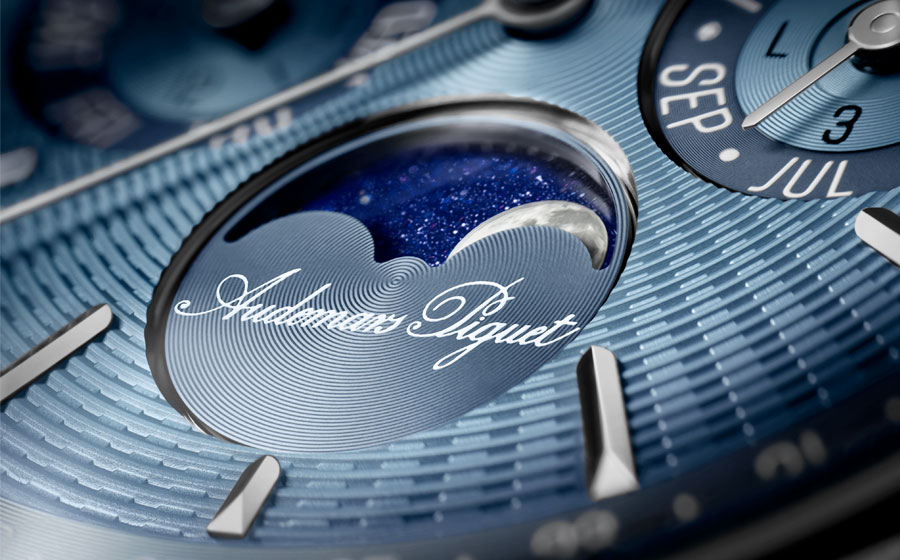
See the technical specifications sheet of the Royal Oak Selfwinding Perpetual Calendar – €108,900
See the technical specifications sheet of the Sand Gold Royal Oak Selfwinding Perpetual Calendar – Price upon request
… and in 38mm
The Royal Oak and Code 11.59 collections are now extended with 3 new self-winding perpetual calendars with unprecedented diameter dimensions for the manufacture: 38mm. Miniaturising one of AP’s emblematic complications without having to compromise neither the ergonomic nor the mechanical sophistication is such a feat for the house.
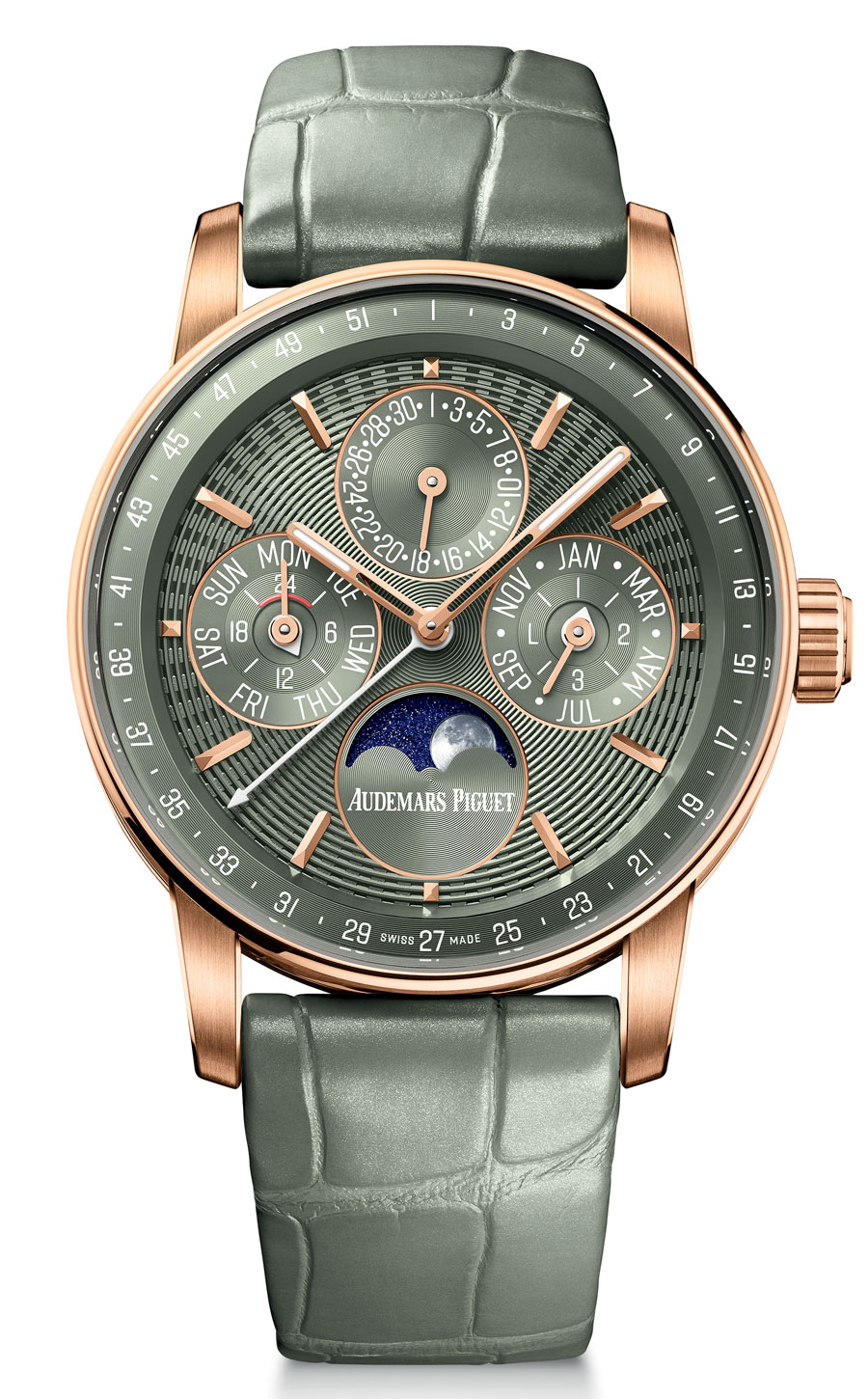
These timepieces are powered by the calibres 7136 and 7138, two new-generation self-winding movements protected by 5 patents. Taking after Calibre 5133, they combine an ultra-thin architecture (4.1mm-thick), a 4Hz frequency and a power reserve of 55 hours.

Their dial gathers all the calendar functions on a single plane, providing liability, thinness and precision. The sapphire case back reveals the 22ct rose gold oscillating weight alongside the hand-finished movement.

These 3 variations stand out by their perfectly balanced look. The rose gold Code 11.59 by Audemars Piguet comes in a variety of green tones, with a guilloche dial that displays a striking play of light.

These timepieces are powered by Calibres 7136 and 7138, 2 new-generation self-winding movements protected by 5 patents. Taking after their predecessor Calibre 5133, they combine an ultra-thin architecture (4.1mm thick), a 4Hz frequency and a power reserve of 55 hours.

As for the dial, the redesigned counters provide an intuitive legibility: day, date, month and leap year indicators are distributed with perfect symmetry, while the realistic moon phase inspired by a NASA photograph is displayed at 6 o’clock. Audemars Piguet introduces as well a patented correction system that is controlled entirely via the crown – making the traditional lateral correctors obsolete and making the perpetual calendar easier to adjust.

See the technical specifications sheet of the Royal Oak Selfwinding Perpetual Calendar – €105,200
See the technical specifications sheet of the Rose Gold Royal Oak Selfwinding Perpetual Calendar – Price upon request
Code 11.59 By Audemars Piguet Starwheel
This new edition of the 41mm Code 11.59 Starwheel mixes black ceramic with 18ct rose gold. With a shiny aventurine dial, this timepiece is inspired by the wandering hours mechanism that was created during the 17th century. Following a special request from Pope Alexander VII who was bothered by the ticking of clocks, the Campani brothers presented a “night clock” displaying the time on a mobile disc that would move along a scaled arch. This system was then used for pocket watches and remained a symbol of prestige for a long time, before disappearing during the 19th century.

This Code 11.59 by Audemars Piguet Starwheel matches 18ct rose gold with black ceramic and shiny aventurine, reinterpreting a historical complication through a refined and modern aesthetics.
In 1989, a watch designer who worked for AP discovered this complication in a specialised magazine. Two years later, the house unveiled the very first Starwheel and its mechanism revealed by 3 transparent sapphire discs. Between 1991 and 2003, about 30 models were produced, paving the way for this poetic complication to return.

The Starwheel model, reintroduced in the Code 11.59 collection in 2022, is now powered with the self-winding Calibre 4310 derived from Calibre 4309. Three aluminium discs, each stamped with 4 numerals, revolve around a central rotor and indicate the time by travelling along a 120° arch. A rose gold seconds hand completes the scenery with elegance. Through a sapphire case back, the movement displays its refined finishing as well as an oscillating weight made of 22ct rose gold. It offers a power reserve of 70 hours, and is water-resistant to 30 meters.
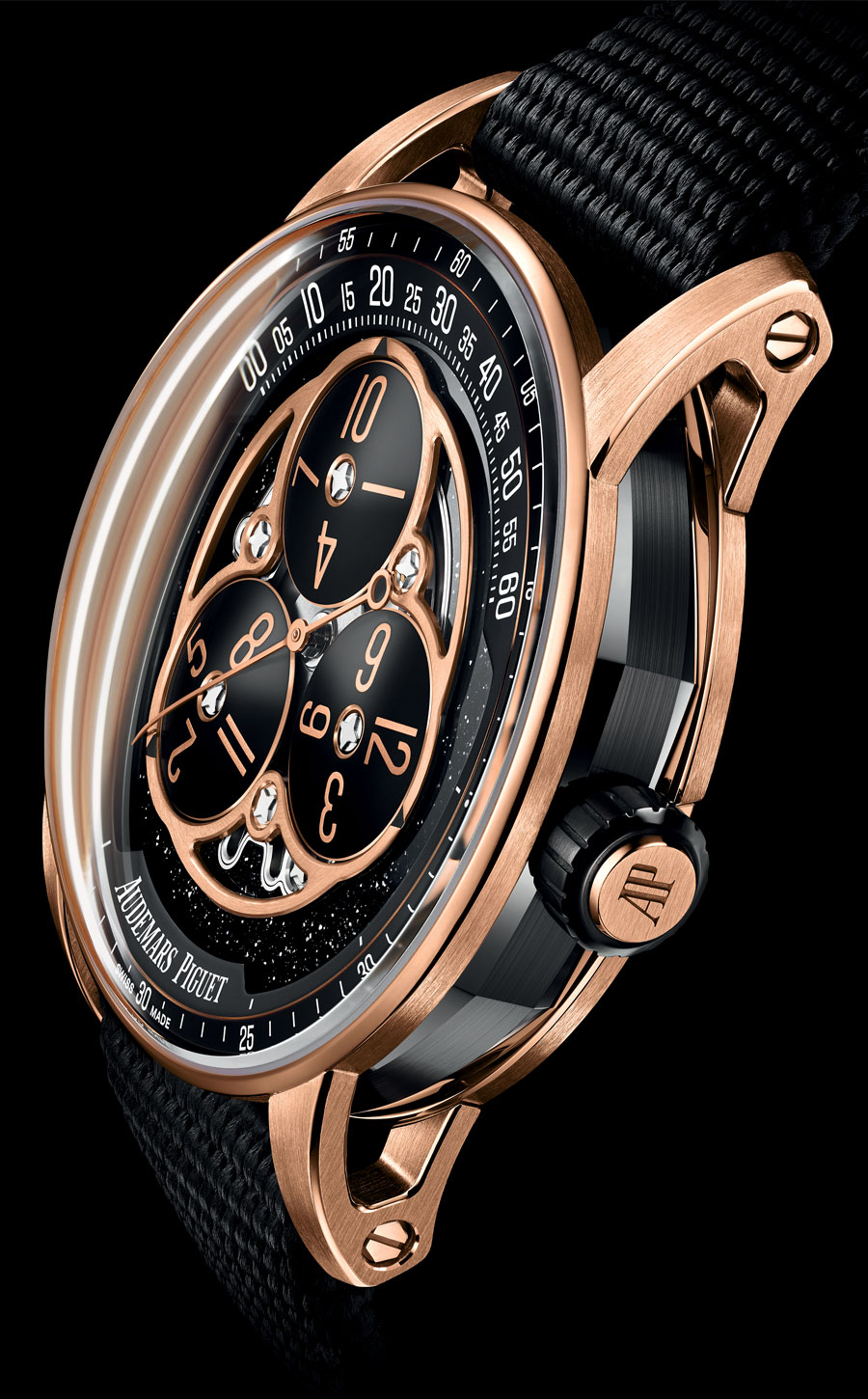
This new Starwheel features alluring contrasts: rose gold bezel and case back, black ceramic case band and an aventurine dial that evokes a starry sky. The opalescent hour discs, whose gilded numerals reflect the golden sheen of the central rotor, create a subtle paly of light. This piece reconciles heritage and modernity, reviving a rare complication through a contemporary aesthetic language.
€59,400
See the technical specifications sheet of the Code 11.59 by Audemars Piguet Starwheel
Royal Oak “Jumbo” Extra-Thin Selfwinding Flying Tourbillon Chronograph RD#5 “150th anniversary”
This Royal Oak “Jumbo” Extra-Thin Selfwinding Flying Tourbillon Chronograph RD#5 is a true technical achievement. It took 5 years of research for it to redefine the concepts of energy, ergonomic and tactile comfort. Its iconic outline nests the brand-new Calibre 8100, with a patented architecture entirely redesigned so that each mechanical part optimises the function’s precision and the controls’ fluidity. For the first time among this collection, this new-generation model reconciles a flyback chronograph and a flying tourbillon – embodying the quintessence of the Swiss manufacture’s know-how.

Royal Oak “Jumbo” Extra-Thin Selfwinding Flying Tourbillon Chronograph RD#5 “150th anniversary”
The Calibre 8100 reinvents the traditional chronograph. With its new innovative rack and pinion system, it gathers energy instead of wasting it, hence making the usual friction spring obsolete. The outcome is an instantaneous fluid zeroing: the seconds hand is reset in less than 0.15 second. A vertical clutch with a column wheel and a peripheral oscillating weight made of platinum were also added, ensuring thinness and visual transparency on the movement. The power reserve reaches 72 hours.

Besides, the RD#5 also stand out with its groundbreaking approach of ergonomic. Dwelling on a detailed tactile study, this watch offers an unprecedented experience to the user: the pushbuttons of the chronograph require a force of only 300 grams for a travel of 0.3mm, reproducing the feeling of a smartphone button. The crown with a function selector makes those adjustments even easier, while preserving the legendary aesthetics of the Royal Oak’s.

As for its design, this “Jumbo” respects its historical proportions – 39mm of diameter for 8.1mm of thickness – while featuring this double complication. The case and the bracelet combine titanium and precious metallic glass (BMG), an alloy made of palladium both sturdy and luminous. Introduced in 2021, this light material resistant to corrosion gives a special sheen to the piece, enhancing its aesthetic balance and providing comfort. The dial colored “Bleu Nuit, Nuage 50” with a Petite Tapisserie motif remains a timeless signature. The snailed counters at 9 o’clock and 3 o’clock provide an optimal legibility, while the rhodium-plated cage at 6 o’clock displays the flying tourbillon that powers the movement. The titanium chronograph hands add even more mechanical reactivity. This Royal Oak RD#5 features a transparent case back that reveals the flawless finishing – hand-bevelling, satin-finishes, reentering angles – and displays the “150” engravement. This edition is limited to 150 copies.
€351,000
See also:
Read also: